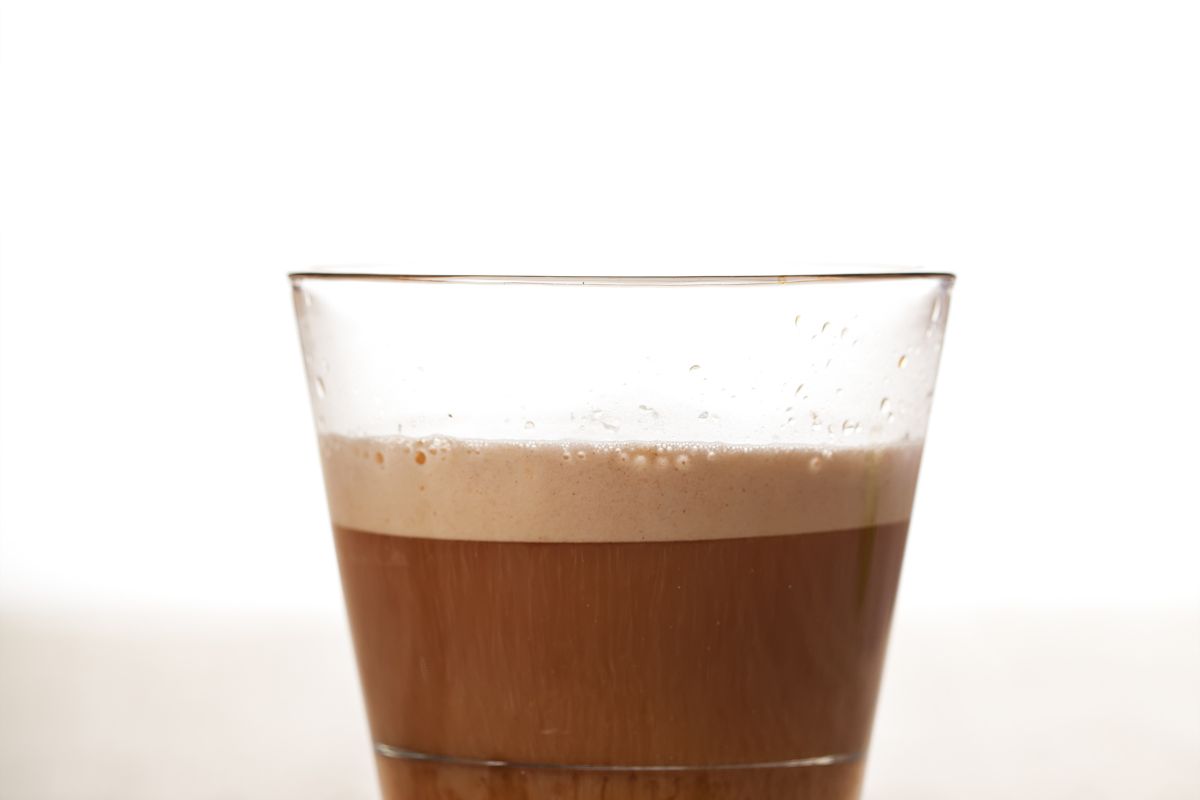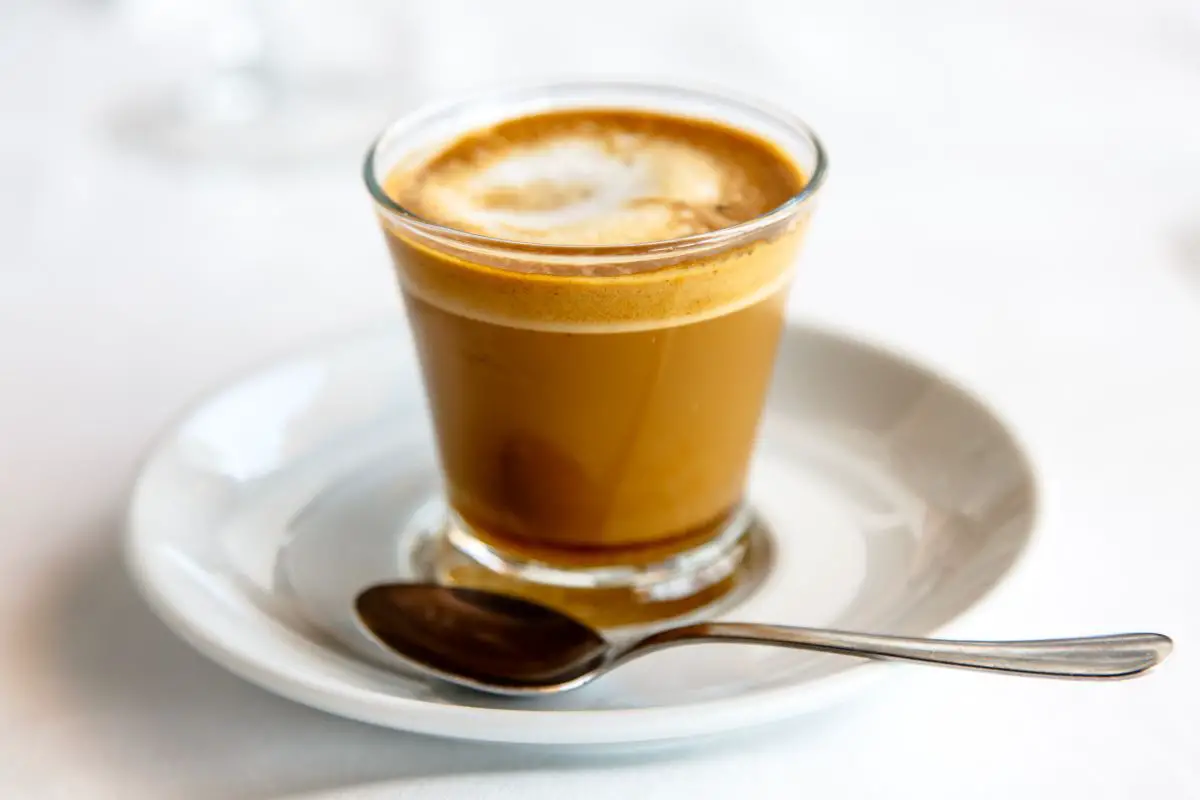In the world of coffee, two beverages stand out for their unique characteristics and distinct flavors: the cortado and the flat white. Like two contrasting notes in a symphony, these drinks offer a harmonious blend of richness and subtlety that captivate the palates of coffee enthusiasts.

Originating from different corners of the globe, the cortado and the flat white have developed their own loyal followings. With origins rooted in Spain and Australia, respectively, these beverages have gained popularity worldwide for their exquisite taste and velvety texture.
Both the cortado and the flat white share a common foundation of espresso and steamed milk. However, the ratio of ingredients and the preparation methods vary, resulting in unique taste profiles and sensory experiences.
In this article, we will delve into the origins, ingredients, and preparation methods of the cortado and the flat white. We will also explore popular variations and additions that allow you to customize your perfect cup. So, join us on this coffee journey as we unravel the nuances of cortado versus flat white and help you make an informed choice for your next caffeine fix.
Key Takeaways
- Cortado and flat white are popular coffee beverages with unique characteristics and flavors.
- Cortado originated in Spain, while flat white originated in Australia and New Zealand.
- Cortado has a 1:1 ratio of espresso to milk, while flat white has a 1:2 ratio.
- Cortado offers a balanced and smooth flavor with a rich, velvety texture, while flat white has a bolder and stronger taste with a velvety-smooth texture.
Origins of Cortado and Flat White
The origins of both the cortado and the flat white can be traced back to different regions, reflecting their unique cultural and historical backgrounds.
The cortado, a traditional Spanish beverage, emerged in the early 20th century in the coffee-rich regions of Spain. It is believed to have originated in the Basque Country and spread throughout the country. The name ‘cortado’ comes from the Spanish word ‘cortar,’ meaning ‘to cut,’ referring to the way it is made by ‘cutting’ the espresso shot with an equal amount of steamed milk.
In contrast, the flat white has its roots in Australia and New Zealand. It gained popularity in the 1980s and is closely associated with the cafe culture in these countries. The exact origin story of the flat white is debated, with both Australia and New Zealand claiming it as their own creation. The drink is made by pouring a double shot of espresso over steamed milk, creating a velvety texture and a thin layer of microfoam on top.
The next section will delve into the differences in ingredients and ratio between the cortado and the flat white, shedding light on their distinct characteristics and flavors.
Ingredients and Ratio
Despite their subtle differences in composition, both coffee beverages consist of a harmonious blend of steamed milk and espresso, resulting in a delightful balance of flavors. The ingredients and ratio used in preparing a cortado and a flat white play a significant role in shaping their distinct characteristics.
- Espresso: Both cortado and flat white are made with a shot of espresso as the base. The espresso provides a strong and robust flavor to the drinks.
- Milk: In a cortado, an equal amount of milk is added to the espresso, creating a 1:1 ratio. This results in a rich and creamy texture with a slightly sweet taste. On the other hand, a flat white has more steamed milk compared to a cortado, creating a 1:2 ratio. This gives the flat white a smoother and velvety texture.
- Microfoam: Both drinks are topped with a thin layer of microfoam, which is created by steaming the milk. The microfoam adds a silky texture and enhances the overall mouthfeel of the beverages.
The ingredients and ratios used in cortado and flat white preparation ensure a well-balanced combination of flavors and textures. This attention to detail sets the stage for the subsequent section, where we explore the taste and texture experience of both coffee beverages.
Taste and Texture Experience

When experiencing the taste and texture of these coffee beverages, one is immediately transported to a realm of sensory delight. The cortado and flat white offer distinct taste profiles and textures that set them apart. The cortado, with its equal parts of espresso and steamed milk, provides a balanced and smooth flavor. It has a rich, velvety texture that coats the palate, leaving a lingering creamy sensation. On the other hand, the flat white, with its double shot of espresso and microfoam milk, delivers a bolder and stronger taste. It has a velvety-smooth texture that is slightly thicker than the cortado, creating a more indulgent mouthfeel. To better understand the differences, the following table provides a comparison of the taste and texture experiences of cortado and flat white:
| Aspect | Cortado | Flat White |
|---|---|---|
| Taste | Balanced, smooth | Bold, strong |
| Texture | Rich, velvety | Velvety-smooth, slightly thicker |
| Mouthfeel | Creamy | Indulgent |
Understanding the taste and texture of these coffee beverages is essential for coffee enthusiasts who desire safety in their choices. Moving forward, we will explore the different preparation methods of cortado and flat white.
Preparation Methods
A journey into the world of coffee preparation unveils the intricate methods employed to craft the cortado and flat white, akin to the delicate and precise strokes of a skilled artist. The preparation methods for these two drinks are distinct, resulting in unique flavor profiles and textural experiences. Understanding these methods can help coffee enthusiasts appreciate the craftsmanship behind each beverage.
- Milk Steaming: Both the cortado and flat white require microfoam, which is achieved by steaming milk to create a velvety texture. The milk should be heated to a specific temperature to avoid scorching and maintain its sweetness.
- Espresso Extraction: A cortado is typically made with a single shot of espresso, while a flat white usually contains a double shot. The espresso extraction process should be carefully monitored to ensure the perfect balance of flavor and aroma.
- Milk-to-Espresso Ratio: The cortado has a higher ratio of milk to espresso compared to the flat white. This results in a milder flavor in the cortado, allowing the espresso to shine through, while the flat white offers a stronger coffee taste.
- Layering Technique: When preparing a cortado, the milk is gently poured into the espresso, creating a layered effect. In contrast, a flat white is characterized by a more integrated mixture of milk and espresso.
Understanding the nuances of preparation methods allows coffee enthusiasts to appreciate the subtle differences between a cortado and a flat white. Moving forward, we will explore popular variations and additions to these beloved coffee beverages.
Popular Variations and Additions
This discussion will focus on two popular variations of coffee, the cortado and flat white, and the different ways in which they can be customized.
One key point to consider is the addition of sweetness to a cortado, which can be achieved by adding flavored syrups or sweeteners.
Additionally, the flat white offers the opportunity to experiment with different milk options, such as almond milk or oat milk, to cater to individual preferences.
Cortado – Adding a Touch of Sweetness
To enhance the flavor profile of a Cortado, a subtle hint of sweetness can be added to complement its rich espresso and velvety milk texture. This can be achieved by incorporating a small amount of sweetener such as vanilla syrup or honey.
The addition of sweetness helps to balance out the boldness of the espresso and adds a touch of indulgence to the drink. However, it is important to exercise caution when adding sweeteners, as too much can overpower the delicate flavors of the Cortado. It is advisable to start with a small amount and gradually adjust to taste.
By carefully incorporating sweetness, the Cortado can be elevated to a new level of enjoyment without compromising its inherent characteristics.
This transition into the subsequent section about ‘flat white – experimenting with different milk options’ allows for further exploration of enhancing the coffee experience.
Flat White – Experimenting with Different Milk Options

In the realm of coffee experimentation, exploring various milk alternatives opens doors to new dimensions of flavor and texture. When it comes to the flat white, the choice of milk can greatly influence the overall taste and mouthfeel.
Here are three milk options to consider:
- Whole Milk: This classic option offers a creamy and rich texture, complementing the strong espresso flavor of the flat white.
- Almond Milk: For those seeking a dairy-free alternative, almond milk adds a subtle nutty flavor to the coffee while providing a lighter texture.
- Oat Milk: Known for its creamy consistency, oat milk creates a velvety smoothness in the flat white, enhancing the overall drinking experience.
By experimenting with different milk options, coffee enthusiasts can discover their perfect cup of flat white. From the traditional whole milk to the plant-based alternatives, the choice of milk plays a vital role in creating a satisfying and enjoyable coffee experience.
Transitioning into the subsequent section, let’s now explore the process of choosing your perfect cup.
Choosing Your Perfect Cup
When considering the selection of your ideal cup, it is imperative to evaluate the nuances and characteristics of both cortado and flat white in order to make an informed decision. The choice between these two popular coffee options ultimately depends on personal preferences and desired taste experience.
The cortado, originating from Spain, is made by combining equal parts espresso and warm milk. This results in a balanced and smooth cup with a rich flavor profile. The use of warm milk in the cortado provides a creamy texture and enhances the natural sweetness of the espresso. The equal ratio of milk to espresso ensures that the coffee flavor remains prominent, making it a popular choice for those who prefer a stronger taste.
On the other hand, the flat white, originating from Australia and New Zealand, is made by pouring micro-foamed milk over a double shot of espresso. This creates a velvety and silky texture, with the milk and espresso flavors blending harmoniously. The micro-foamed milk adds a delicate layer of foam that enhances the overall mouthfeel and gives the flat white a distinct appearance.
Choosing between a cortado and a flat white requires an understanding of the unique characteristics of each. The cortado offers a balanced and smooth taste, while the flat white provides a velvety texture and harmonious blend of flavors. Ultimately, the decision should be based on personal taste preferences and desired coffee experience.
Frequently Asked Questions
Are cortado and flat white the same type of coffee?
Cortado and flat white are not the same type of coffee. While both beverages involve the combination of espresso and steamed milk, the proportions and milk textures used in each drink differ, resulting in distinct flavor profiles and overall experiences.
Can I make a cortado or flat white at home without a coffee machine?
Making a cortado or flat white at home without a coffee machine is challenging. However, it is possible to create a similar drink by frothing milk manually and using a stove-top espresso maker.
How does the taste of a cortado differ from a flat white?
The taste of a cortado differs from a flat white in terms of the ratio of milk to espresso. A cortado has a 1:1 ratio, resulting in a stronger espresso flavor, while a flat white has a higher milk to espresso ratio, resulting in a creamier and milder taste.
Are cortado and flat white popular in all countries?
Cortado and flat white have gained popularity worldwide, although their level of popularity may vary by country. The global coffee culture has embraced these beverages due to their unique flavors and the growing interest in specialty coffee.
Can I customize the ratio of milk to espresso in a cortado or flat white?
Yes, it is possible to customize the ratio of milk to espresso in both cortado and flat white. This allows individuals to tailor their drink according to their preferences and dietary restrictions.
Conclusion
Cortado and Flat White are two popular coffee beverages with distinct origins, ingredients, and preparation methods.
The Cortado hails from Spain and is made with equal parts espresso and steamed milk, while the Flat White originates from Australia and consists of a double shot of espresso and a small amount of steamed milk.
Both beverages offer unique taste and texture experiences, with the Cortado being smoother and less acidic, and the Flat White providing a velvety mouthfeel.
Popular variations and additions include flavored syrups and latte art. When choosing between the two, it ultimately comes down to personal preference.
One interesting statistic is that the popularity of Cortado has been steadily increasing in recent years. In the United States alone, the search interest for Cortado has more than doubled in the past five years, indicating a growing interest in this particular coffee beverage.
This visual representation highlights the evolving coffee preferences and the increasing demand for unique and lesser-known options in the market.
Related articles:
